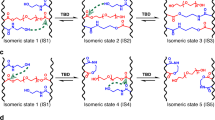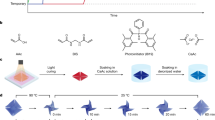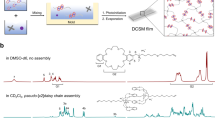Abstract
Shape memory polymers are materials that can memorize temporary shapes and revert to their permanent shape upon exposure to an external stimulus such as heat1, light2,3, moisture4 or magnetic field5. Such properties have enabled a variety of applications including deployable space structures6, biomedical devices7,8, adaptive optical devices9, smart dry adhesives10 and fasteners11. The ultimate potential for a shape memory polymer, however, is limited by the number of temporary shapes it can memorize in each shape memory cycle and the ability to tune the shape memory transition temperature(s) for the targeted applications. Currently known shape memory polymers are capable of memorizing one or two temporary shapes, corresponding to dual- and triple-shape memory effects (also counting the permanent shape), respectively11,12,13. At the molecular level, the maximum number of temporary shapes a shape memory polymer can memorize correlates directly to the number of discrete reversible phase transitions (shape memory transitions) in the polymer11,12,13. Intuitively, one might deduce that multi-shape memory effects are achievable simply by introducing additional reversible phase transitions. The task of synthesizing a polymer with more than two distinctive and strongly bonded13 reversible phases, however, is extremely challenging. Tuning shape memory effects, on the other hand, is often achieved through tailoring the shape memory transition temperatures, which requires alteration in the material composition14,15,16. Here I show that the perfluorosulphonic acid ionomer (PFSA), which has only one broad reversible phase transition, exhibits dual-, triple-, and at least quadruple-shape memory effects, all highly tunable without any change to the material composition.
This is a preview of subscription content, access via your institution
Access options
Subscribe to this journal
Receive 51 print issues and online access
$199.00 per year
only $3.90 per issue
Buy this article
- Purchase on Springer Link
- Instant access to full article PDF
Prices may be subject to local taxes which are calculated during checkout



Similar content being viewed by others
References
Liu, C., Qin, H. & Mather, P. T. Review of progress in shape-memory polymers. J. Mater. Chem. 17, 1543–1558 (2007)
Lendlein, A., Jiang, H., Junger, O. & Langer, R. Light-induced shape-memory polymers. Nature 434, 879–882 (2005)
Koerner, H. et al. Remotely actuated polymer nanocomposites—stress-recovery of carbon-nanotube-filled thermoplastic elastomers. Nature Mater. 3, 115–120 (2004)
Huang, W. et al. Water-driven programmable polyurethane shape memory polymer: demonstration and mechanism. Appl. Phys. Lett. 86, 114105 (2005)
Mohr, R. et al. Initiation of shape-memory effect by inductive heating of magnetic nanoparticles in thermoplastic polymers. Proc. Natl Acad. Sci. USA 103, 3540–3545 (2006)
NASA. Elastic memory composite hinges tested on shuttle. NASA Tech. Briefs 31, 20 〈http://www.techbriefs.com/component/content/article/1344〉 (2007)
Lendlein, A. & Langer, R. Biodegradable, elastic shape-memory polymers for potential biomedical applications. Science 296, 1673–1676 (2002)
Yakacki, C. M. et al. Strong, tailored, biocompatible shape-memory polymer networks. Adv. Funct. Mater. 18, 2428–2435 (2008)
Kunzelman, J., Chung, T., Mather, P. T. & Weder, C. Shape memory polymers with built-in threshold temperature sensors. J. Mater. Chem. 18, 1082–1086 (2008)
Xie, T. & Xiao, X. Self-peeling reversible dry adhesive. Chem. Mater. 20, 2866–2868 (2008)
Bellin, I., Kelch, S., Langer, R. & Lendlein, A. Polymeric triple-shape materials. Proc. Natl Acad. Sci. USA 103, 18043–18047 (2006)
Behl, M. et al. One-step process for creating triple-shape capability of AB polymer networks. Adv. Funct. Mater. 19, 102–108 (2009)
Xie, T., Xiao, X. & Cheng, Y. T. Revealing triple-shape memory effect by polymer bilayers. Macromol. Rapid Commun. 30, 1823–1827 (2009)
Xie, T. & Rousseau, I. A. Facile tailoring of thermal transition temperatures of epoxy shape memory polymers. Polymer 50, 1852–1856 (2009)
Liu, C. & Mather, P. T. Thermomechanical characterization of a tailored series of shape memory polymers. J. Appl. Med. Polym. 6, 47–52 (2002)
Liu, C. et al. Chemically cross-linked polycyclooctene: synthesis, characterization, and shape memory behavior. Macromolecules 35, 9868–9874 (2002)
Mauritz, K. A. & Moore, R. B. State of understanding of Nafion. Chem. Rev. 104, 4535–4585 (2004)
Page, K. A., Cable, K. M. & Moore, R. B. Molecular origins of the thermal transitions and dynamic mechanical relaxations in perfluorosulfonate ionomers. Macromolecules 38, 6472–6484 (2005)
Weiss, R., Izzo, E. & Mandelbaum, S. New design of shape memory polymers: mixtures of an elastomeric ionomer and low molar mass fatty acids and their salts. Macromolecules 41, 2978–2980 (2008)
Deng, Q., Wilkie, C. A., Moore, R. B. & Mauritz, K. A. TGA-FTi.r. investigation of the thermal degradation of Nafion and Nafion/silicon oxide-based nanocomposites. Polymer 39, 5961–5972 (1998)
Xie, T. & Hayden, C. A. A kinetic model for the chemical degradation of perfluorinated sulfonic acid ionomers: weak end groups versus side chain cleavage. Polymer 48, 5497–5506 (2007)
Yakacki, C. M. et al. Unconstrained recovery characterization of shape-memory polymer networks for cardiovascular applications. Biomaterials 28, 2255–2263 (2007)
Gall, K. et al. Thermomechanics of the shape memory effect in polymers for biomedical applications. J. Biomed. Mater. Res. A 73A, 339–348 (2005)
Rodriguez, E., Luo, X. & Mather, P. T. Miscible blends of linear and crosslinked poly(ε-caprolactone) for shape memory assisted self-healing. Mater. Res. Soc. Fall Meet. Symp. BB (Polymer-Based Smart Materials–Process, Properties, and Application) abstr. BB5.19 (2008)
Miaudet, P. et al. Shape and temperature memory of nanocomposites with broadened glass transition. Science 318, 1294–1296 (2007)
Gall, K. et al. Internal stress storage in shape memory polymer nanocomposites. Appl. Phys. Lett. 85, 290–292 (2004)
Li, J., Viveros, J. A., Wrue, M. H. & Anthamatten, M. Shape-memory effects in polymer networks containing reversibly associating side-groups. Adv. Mater. 19, 2851–2855 (2007)
Kushner, A. M., Vossler, J. D., Williams, G. A. & Guan, Z. A biomimetic modular polymer with tough and adaptive properties. J. Am. Chem. Soc. 131, 8766–8768 (2009)
Ping, P., Wang, W., Chen, X. & Jing, X. Poly(ε-caprolactone) polyurethane and its shape memory property. Biomacromolecules 6, 587–592 (2005)
Acknowledgements
I thank I. Rousseau, H. Kia, P. Krajewski, X. Huang and M. Verbrugge for comments, D. Eckel for Infrared analysis, and R. L. Speer Jr for X-ray analysis.
Author information
Authors and Affiliations
Corresponding author
Ethics declarations
Competing interests
The author declares no competing financial interests.
Supplementary information
Supplementary Information
This file contains Supplementary Methods and Supplementary Figures S1-S9 with Legends. (PDF 263 kb)
Rights and permissions
About this article
Cite this article
Xie, T. Tunable polymer multi-shape memory effect. Nature 464, 267–270 (2010). https://doi.org/10.1038/nature08863
Received:
Accepted:
Issue Date:
DOI: https://doi.org/10.1038/nature08863
This article is cited by
-
Recent advances in multifunctional shape memory photonic crystals and practical applications
Nano Research (2024)
-
Shape memory polymer with programmable recovery onset
Nature (2023)
-
4D printing of shape memory polymer with continuous carbon fiber
Progress in Additive Manufacturing (2023)
-
Viewpoint: Tuning the Martensitic Transformation Mode in Shape Memory Ceramics via Mesostructure and Microstructure Design
Shape Memory and Superelasticity (2023)
-
Spinodal dynamics of metastable glass transition domains in amorphous polymer towards thermomechanically tailorable shape memory effect
Science China Technological Sciences (2023)
Comments
By submitting a comment you agree to abide by our Terms and Community Guidelines. If you find something abusive or that does not comply with our terms or guidelines please flag it as inappropriate.



